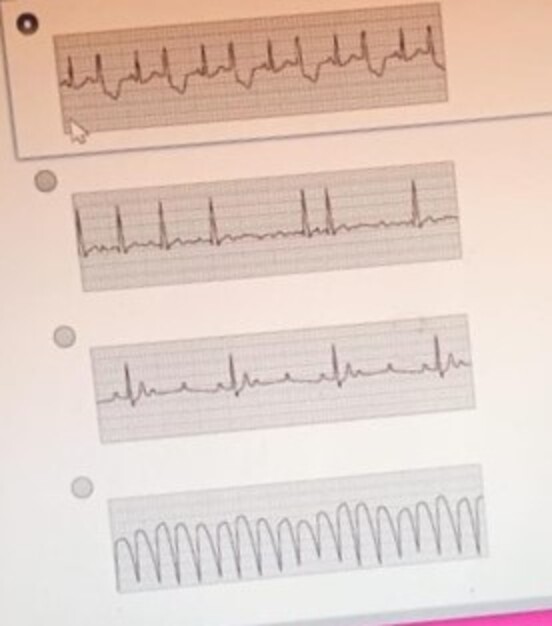A nurse is reviewing ECG rhythm strips for a group of clients. The nurse should identify that which of the following rhythms indicates bradycardia?

A
B
C
D
The Correct Answer is C
Sinus bradycardia is a type of cardiac arrhythmia characterized by a heart rate lower than 60 beats per minute in adults, or below the normal range for age in children. It can be diagnosed by an electrocardiogram (ECG) that shows regular P waves with constant morphology preceding every QRS complex, and positive in lead II.
Nursing Test Bank
Naxlex Comprehensive Predictor Exams
Related Questions
Correct Answer is C
Explanation
This is because the client is experiencing bradycardia, which is a slow heart rate of less than 60/min. Bradycardia can cause decreased cardiac output, which can lead to symptoms such as tremors, fainting, dizziness, chest pain, shortness of breath, and hypotension. Some causes of bradycardia are sinus node dysfunction, atrioventricular block, medication side effects, hypothyroidism, hypothermia, and increased vagal tone.
The nurse should anticipate administering atropine sulfate, which is an anticholinergic drug that blocks the action of the vagus nerve on the heart and increases the heart rate and conduction. Atropine sulfate is the first-line drug for symptomatic bradycardia and can be given intravenously or intramuscularly. The nurse should monitor the client's vital signs, cardiac rhythm, and response to the medication. The nurse should also prepare for other interventions, such as transcutaneous pacing or permanent pacemaker insertion, if atropine sulfate is ineffective or contraindicated.
Correct Answer is B
Explanation
Choice a.This response may come across as challenging or confrontational. While the nurse is asking for more information, the phrasing could inadvertently put the client on the defensive. It doesn't validate the client's feelings and may not encourage a productive dialogue.
- Choice b. “Suggesting peer support or mentorship from someone who has gone through a similar experience could be beneficial in some situations, as it may help the client feel less isolated.
- Choice c. “Most people can adjust following this surgery.” may be true, but it does not acknowledge the client’s individual experience and feelings. It may also sound dismissive or minimizing of the client’s challenges.
- Choice d. “You are upset. We can talk about this later.” may be intended to give the client some space, but it does not convey empathy or support. It may also make the client feel rejected or ignored.
Whether you are a student looking to ace your exams or a practicing nurse seeking to enhance your expertise , our nursing education contents will empower you with the confidence and competence to make a difference in the lives of patients and become a respected leader in the healthcare field.
Visit Naxlex, invest in your future and unlock endless possibilities with our unparalleled nursing education contents today
Report Wrong Answer on the Current Question
Do you disagree with the answer? If yes, what is your expected answer? Explain.
Kindly be descriptive with the issue you are facing.
